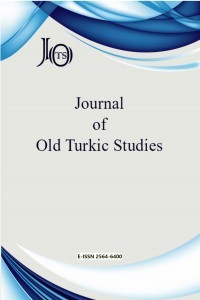Cüveynî’nin Târîh-i Cihân-Güşâ Adlı Yazmasına Eklenen Sözlük
Tarīkh-i Jahān-gushā by Ata-Malik Juvayni was written in the thirteenth century. A critical edition of this book was published at the beginning of the twentieth century in Europe. The same book was published recently in Tehran. This text is in Persian, but contains many Turkic and Mongolian words. The study of these words has recently become a linguistic issue in Iran. A number of people have studied the Turkish words in this text in an idiosyncratic folk etymological manner. This article deals with a brief critical review of these studies. Also treated here are some linguistic aspects of the Turkish words in the text and there is a translation of an extract from the book about the old Uygurs and an old inscription on a rock. A new manuscript of Tarīkh-i Jahān-gushā from the Iranian National Parliament Library is then introduced. It is different from previous manuscripts in having as a supplement a glossary of Turkish and Mongolian words in the manuscript. The words in this glossary are copied, transcribed and their definitions translated from Persian into Turkish.
Anahtar Kelimeler:
Tarīkh-i Jahān-gushā, Turkish, Persian, Mongolian, manuscript
A Wordlist Added to the Manuscript of Tarīkh-i Jahān-gushā by Ata-Malik Juvayni
Tarīkh-i Jahān-gushā by Ata-Malik Juvayni was written in the thirteenth century. A critical edition of this book was published at the beginning of the twentieth century in Europe. The same book was published recently in Tehran. This text is in Persian, but contains many Turkic and Mongolian words. The study of these words has recently become a linguistic issue in Iran. A number of people have studied the Turkish words in this text in an idiosyncratic folk etymological manner. This article deals with a brief critical review of these studies. Also treated here are some linguistic aspects of the Turkish words in the text and there is a translation of an extract from the book about the old Uygurs and an old inscription on a rock. A new manuscript of Tarīkh-i Jahān-gushā from the Iranian National Parliament Library is then introduced. It is different from previous manuscripts in having as a supplement a glossary of Turkish and Mongolian words in the manuscript. The words in this glossary are copied, transcribed and their definitions translated from Persian into Turkish.
Keywords:
Tarīkh-i Jahān-gushā, Turkish, Persian, Mongolian, manuscript,
___
- Atalay, B. (1998). Divanü Lugat-it-Türk Tercümesi I-IV. Türk Dil Kurumu Yayınları.
- Aydinlu, S. (1396 H. Ş.). Negâhî be Vâjehâ-ye Torkî-ye Şâhname-ye Ferdowsî [Firdevsi’nin Şâhnamesinde Türkçe Kelimelere Bir Bakış]. Metn-Şenâsî-ye Edeb-e Fârsî, 12(2), 11-36.
- Azmun, Y. (2007). Burhan-ı Katı (Katı Burhan). Türk Dili ve Edebiyatı Araştırmaları Dergisi, 13(1), 35-46.
- Azmun, Y. (2016). Söz Kökümiz Öz Kökümiz. Gün Neşiryatı.
- Caferî, S. & Âlîzâde, M. (1399 H. Ş.). Tahlîl-e Sâḫtârî ve Maᶜnâî-ye Berḫî Aᶜlâm-e Torkî-ye Târîḫ-e Cihân-güşâ-ye Cuveynî [Cüveynî’nin Târîh-i Cihân-güşâ’sında Bazı Türkçe Terimlerin Yapısal ve Semantik Analizi]. Metn-Şen’asî-ye Edeb-e Farsî, 12(2), 113-127.
- Clauson, S. G. (1972). An Etymological Dictionary of Pre-Thirteenth-CenturyTurkish. Oxford University Press.
- Doerfer, G. (1963). Türkische und Mongolische Elemente im Neupersischen, unter Besonderer Berücksichtigung älterer neupersischer Geschichtsquellen, vor allem der Mongolen- und Timuriszeit I. Franz Steiner Verlag.
- Ercilasun, A. B. (2020). Atâ Melik Cüveynî Neler Gördü, Neler Duydu? Türk Dili, 822, 4-9.
- Eren, H. (1999). Türk Dilinin Etimolojik Sözlüğü. Ankara.
- Erşâdîfer, A. (1379). Ferheng-e Vajgân-e Torkî der Zebân ve Edebiyât-e Fârsî [Fars Dili ve Edebiyatında Türkçe Sözlerin Sözlüğü]. Bâġ-e Endîşe.
- Ethé, H. (1351). Târîḫ-e Edebiyât-e Fârsî. Farsçaya Çev. Şafak, R. Emîr Kebîr.
- Hâtemî, A. (1373). Şerh-e Moşkelât-e Târîḫ-e Cihân-güşâ-yı Cuveynî [Cüveynî’nin Târîh-i Cihân-güşâ’sının Zorluklarının Açıklanması]. Baba.
- Houtsma, A. (1894). Ein türkisch-arabisches Glossar. E.J. Brill.
- Kazvînî, M. (2008). Târîḫ-i Cihân-güşâ-yı Cüveynî. Hermes.
- Koçoğlu, T. & Ahmadoughli, A. (2020). Cüveynî’nin Târîh-i Cihân-güşâsı’ndaki Bazı Türkçe-Moğolca Kelimeleri Açıklayan Bir Lügatçe. KARE, 9, 91-132.
- Lessing, F. D. (2003). Moğolca-Türkçe Sözlük I-II. Çev. Karaağaç, G. Türk Dil Kurumu Yayınları.
- Moin, M. (1381). Ferheng-e Fârsî. Emîr Kebîr.
- Mûsevî, M., (1384). Vâjgân-e Torkî ve Moğolî-ye Târîḫ-e Cihân-güşâ-ye Cuveynî [Târîḫ-i Cihân-güşâ’da Türkçe ve Moğolca Sözler]. Âyîne-ye Mîrâs, 30-31, 59-89.
- Nâînî, M. S. (1380). Vajgân-e Torkî der Zebân-e Fârsî [Farsçada Türkçe Sözler]. Peyâm.
- Öztürk, M. (1998). Târîh-i Cihân-Güşâ. Kültür Bakanlığı Yayınları.
- Rezâyî, M. (1398). Ertebât-e Zebânhâ-ye Torkî, Moğolî, Ḫatâ der Teşḫîs-e Vâjehâ-ye Daḫîl-e Torkî ve Moğolî der Zebân-e Fârsî [Türk, Moğol ve Hıtay Dillerinin Fars Dilindeki Türkçe ve Moğolca Sözlerle İlişkisi]. Zebân-Pejûhî-ye Daneşgâh-e El- Zehrâ, 11(36), 7-20.
- Şeyh Süleyman Efendi (1298). Lugat-i Çağatay ve Türkî-yi Osmânî. Mihrân.
- Türkiye’de Halk Ağzından Derleme Sözlüğü I-XII (1993). II. Baskı. Türk Dil Kurumu Yayınları.
- XIII. Yüzyıldan Beri Türkiye Türkçesiyle Yazılmış Kitaplardan Toplanan Tanıklarıyla Tarama Sözlüğü (1996). 8 Cilt. II. Baskı. Türk Dil Kurumu Yayınları.
- Yayın Aralığı: Yılda 2 Sayı
- Başlangıç: 2017
- Yayıncı: Erdem UÇAR
Sayıdaki Diğer Makaleler
Seçili Anlam Alanındaki Kök Dal Biçimlere Ulaşmada Yeni Bir Yöntem Denemesi
Türk Bengü Taşları Örneğinde Anlam Yapısı Çözümlemesi
Budist Uygurlarda Abhiseka Ritüeli
Cüveynî’nin Târîh-i Cihân-Güşâ Adlı Yazmasına Eklenen Sözlük
